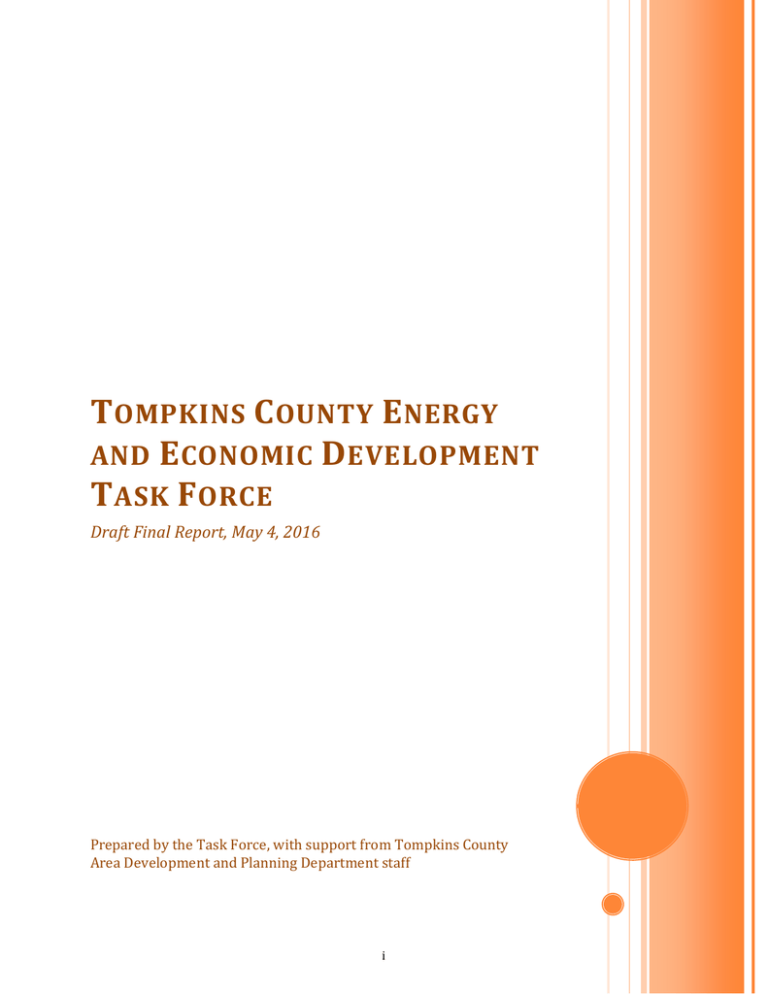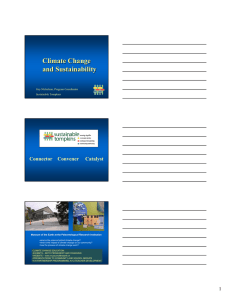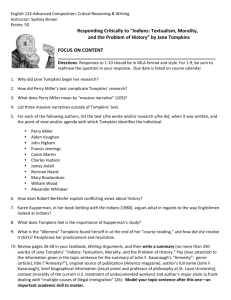tompkins county energy and economic development task force
advertisement

T OMPKINS C OUNTY E NERGY AND E CONOMIC D EVELOPMENT T ASK F ORCE DraftFinalReport,May4,2016 PreparedbytheTaskForce,withsupportfromTompkinsCounty AreaDevelopmentandPlanningDepartmentstaff i EnergyandEconomicDevelopmentTaskForce Latein2014,CountyPlanningCommissionerEdMarxandTompkinsCountyAreaDevelopment DirectorMichaelStammformallycommittedtheirorganizationstocollaborateonaddressinglong‐ termandimmediateenergyneedsandemissionsinwaysthatcontributetoavitallocaleconomy. Inaco‐authoreddocument,apledgewasmadetobring“abroadvarietyofvoicestothediscussionof communitygoalsandstrategies,aswellastangiblestepstomeetbothenergyandeconomic developmentgoals.”Itwasalsoagreedthat“discourseinthecommunityaroundthetopicsof economicdevelopment,energy,andgreenhousegasemissionsmustbebasedonclearandaccurate informationandoccurinacivilandrespectfulmanner.” Recognizingtheclearneedforsuchinformeddiscourse,andthedesirabilityofanactiveengagement withmembersofthelocalbusinesscommunity,LegislatureChairMikeLaneaskedMichaelStammto considercreatingaTCADworkgroupbasedontheseprinciplesandtoworkwithCountystaffto definehowsuchagroupwouldbeorganizedandwhereitsfocuswouldbemosteffectivelydirected. Overthepastyear,this19‐persontaskforce,chairedbySciencenterExecutiveDirectorCharlie Trautmann,andmadeupofabalancedmixofindividualswithexpertiseinrenewableandtraditional energyresources,businessoperation,realestatedevelopmentandotheraspectsofthecommunityhas beenmeetingtodevelopthisreportandrecommendations. TaskForceMemberswere: PeterBardaglio,President,BlackOakWindFarm&Coordinator,TCClimateProtectionInitiative RobertBland,AssociateVicePresidentofEnergyandSustainability,CornellUniversity MikeCannon,VicePresidentCommercialBanking,TompkinsTrustCompany GrahamGillespie,President,HOLTArchitects JerryGoodenough,ChiefOperatingOfficer,UpstateNewYorkPowerProducers MelissaKemp,DirectorofCommercialandUtilityDevelopment,RenovusSolar MichaelLane,Chair,TompkinsCountyLegislature GlennMorey,Legislator,TompkinsCountyLegislature MarthaRobertson,TompkinsCountyLegislature KenSchlather,ExecutiveDirector,CornellCooperativeExtensionofTompkinsCounty HermanSieverding,VicePresidentofIntegratedAcquisitionsandDevelopmentCorporation JenniferTavares,President,TompkinsCountyChamberofCommerce MikeThorne,SuperintendentofPublicWorks,CityofIthaca CharlieTrautmann,ExecutiveDirector,Sciencenter IreneWeiser,Councilwoman,TownofCaroline SteveWelliver,ExecutiveVicePresident,WelliverMcGuireInc. JoeMareane,CountyAdministrator,TompkinsCounty(non‐votingmember) EdMarx,Commissioner,TompkinsCountyPlanningDepartment(non‐votingmember) MichaelStamm,President,TompkinsCountyAreaDevelopment(non‐votingmember) TheSupportTeam MarthaArmstrong,VP&DirectorofEconomicDevelopmentPlanning,TCAreaDevelopment KatherineBorgella,DeputyCommissioner,TCPlanningDepartment JudyRowe,J.A.RoweConsulting ii TABLEOFCONTENTS EXECUTIVESUMMARY...........................................................................................................1 INTRODUCTION........................................................................................................................1 OVERVIEW..................................................................................................................................2 KEYISSUES:ENERGY,GHGEMISSIONSANDECONOMICDEVELOPMENT...........5 WHATWELEARNED............................................................................................................10 RECOMMENDATIONSOFTHETASKFORCE.................................................................10 TASKFORCECONTRIBUTIONSTORECENTINITATIVES........................................14 SUMMARY................................................................................................................................15 REFERENCES...........................................................................................................................15 APPENDICES(seeseparatedocument) PublicOutreachandComments.................................................................A MeetingScheduleandTopicsCovered.....................................................B GlossaryofEnergy‐relatedActivitiesinTompkinsCounty..............C FieldVisitsbyTaskForceMembers..........................................................D StatementtothePSConBehalfoftheTaskForce................................E ListofAdditionalRecommendationsforFutureConsideration.....F EnergyandEconomicDevelopmentTaskForceCharge...................G iii ExecutiveSummary Draft:May4,2016 (Tobewrittenoncereporthasbeenreviewed) INTRODUCTION In2014,aproposedgasdistributionpipelinealongWestDrydenRoadsparkedconsiderable communitydebateovertheapparentconflictbetweeneconomicdevelopmentandtheTompkins CountyLegislature’s(TCL)statedgoalofreducinggreenhousegas(GHG)emissionsatleast80%, comparedto2008levels,by2050.Asaresultofthisdebate,theTCLandthecommunity’seconomic developmentagency,TompkinsCountyAreaDevelopment(TCAD),recognizedtheneedtocreate anenvironmentwhereaproductivediscoursecouldtakeplaceandpracticalsolutionstomeetboth goalscouldbedeveloped. TCLaskedTCADtoconvenetheTompkinsCountyEnergyandEconomicDevelopmentTaskForce (EEDTF)toaddresstheissueduring2015and2016.Thegroup,listedontheinsidecover,was diverseandbroad‐based.Itincluded16votingmembersrepresentingtheTompkinsCounty Legislature,climateadvocacy,housingandindustrialdevelopment,CornellUniversity, construction,renewableenergy,theCityofIthaca,andvariousotherconstituencies.Thegroup includedthreenon‐votingmembers,thePresidentofTCAD,theTCCommissionerofPlanning,and theTompkinsCountyAdministrator,plussupportfromTCADandTompkinsCountyPlanning Department(TCPD)staffandaconsultantwhospecializedincoachinghigh‐performanceteams. ThegroupwaschairedbyCharlieTrautmann,executivedirectoroftheSciencenterandadjunct associateprofessoratCornell’sSchoolofCivil&EnvironmentalEngineering. Chargeandscope.TheEEDTFcharge,includedasAppendixG,wastorecommendshort‐term actionsthatcouldbeinitiatedunderlocalcontrolwithin3‐5yearsthatwould,inturn,advancethe TCL’sGHGemissionsgoalswhile,atthesametime,alsoadvancingeconomicdevelopmentin TompkinsCounty. TherecommendationsoftheTaskForceweretoconsiderthetriplebottomline(abalanceof environmental,equity,economicfactors).TheTaskForcewasalsochargedwithcoordinatingits effortswithotherongoingorplannedenergyprojects,suchastheTompkinsCountyEnergy Roadmap(along‐termplanningeffortcompletedinearly2016)andanupdateoftheTompkins CountyEnergyStrategy(tobegininmid‐2016).AppendixCcontainsaGlossaryofEnergy‐Related Projects. Tokeepitsworkfocused,therewereseveralexclusionsinthecharge.WhiletheEEDTFtookthese exclusionaryissuesintoconsideration,itdidnottrytospecificallyresolvelongstandingissuesthat couldnotberealisticallyaddressedinits12‐monthtimeframe,suchashousingsupply(specifically forlow‐moderateincomeresidents),transportationasrelatedtoruraldevelopment,andthere‐ poweringtheAESCayugapowerstationinLansingwithnaturalgas. ProcessusedbytheTaskForce.TheEEDTFheldaseriesof18meetingsfromJune2015through May2016.TheinitialmeetingsfocusedonTaskForcememberslearningaboutvariousaspectsof energyandeconomicdevelopment,takingadvantageofitsownmemberexpertisealongwiththat 1 ofoutsideexperts.Manymemberscontributedtheirexpertise,experience,andresearch.Thegroup heldapublicinputsessiononOctober27,2015,whichwasattendedby50individuals.Subsetsof thegroupstudiedspecifictopics,tookfieldtripstoenergyinstallations,suchasCornell’sCombined HeatandPowersystem,theFranziskaRackerCentersheatpumpsystem,andtheNYIndependent SystemOperatorinAlbany.Variousmembersofthegroupalsointerviewedexperts. Acknowledgments.TheEEDTFgratefullyacknowledgestheeffortsandsupportofmany individualsandgroupswithoutwhosesupportitsworkwouldnothavebeenpossible.TCL convenedthegroup,hadthreemembersparticipateandprovidedadministrativesupport.TCPD andTCADparticipatedfullyinthemeetingsandprovidedbothfundingandadministrativesupport. JudyRoweofJudyRoweConsultinghelpedthegroupfindearlycommongroundandhelped developproductiveworkingrelationships.TheSciencenterandTompkinsCountyChamberof Commercecontributedtheirfacilitiesformeetings.Anumberofoutsideexpertsgavefreelyoftheir timeineducatingthegroup,includingFernandodeAragon,ScottBochenek,GordonBoyd,Brian Conroy,MichaelEastman,IanShapiro,andBriceSmith. TheEEDTFthanksitsexofficiomembersfortheirtimeandexpertise:EdMarx,MichaelStamm,and JoeMareane.TheTaskForceisparticularlyindebtedtoMarthaArmstrong(TCAD)andKatie Borgella(TCPD)fortheirdedication,longhours,andorganizationalexpertise.Additionally,the TaskForcewouldliketoacknowledgethetime,care,andexpertisethatCharlieTrautmann,chairof thegroup,broughttothediscussions.Hisabilitytohomeinonkeypointsandlistentoconcerns expressedbythememberswasmuchappreciatedandcriticaltotheworkoftheTaskForce. Finally,wewouldliketoacknowledgeallmembersoftheTaskForcefortheireffortsonbehalfof theresidents,businesses,andvisitorsofTompkinsCounty.Whileindividualmembershavedeeply heldpersonalviewsonmanyaspectsofclimatechangeandeconomicdevelopment,theyeach strovetobringtheirbestcreativethinkingtotheTaskForceandworkedtoachieveaconsensus documentwithrecommendationstomakethecommunitystrongerasweembracethistransitionto anewgreenenergyeconomy. OVERVIEW ThetotalgrossproductofTompkinsCountyisabout$7billion,with48%associatedwithlocal goodsandservicesand52%associatedwithTradedSectors,orbusinessesprovidingproductsto besoldoutsidethecounty.Education(27%)andManufacturing&Hi‐Tech(18%)areTraded Sectorsandtogetherrepresent45%,ornearlyone‐halfoftheentiregrossproductoftheCounty (TCAD,2015‐2020EconomicDevelopmentStrategy) Withrespecttoenergysupply,TompkinsCountyisinastateoftransition.Naturalgaspricesare currentlyextremelylowbecausefrackinghasincreasedthesupplyofinexpensivenaturalgasfrom theMarcellusshaleandotherU.S.geologicformations.Coalisrapidlydecliningasafuelforpower plantsbecauseofitscostandenvironmentalimpacts. HalfofthepowerusedbyNewYorkStateisgeneratedbygas‐firedpowerplants.Gasiscurrently theprimarysourceoffuelforheatinghomesandbusinessesintheCounty,withpropaneusedin manyruralhomes. Gasolineanddiesel(bothfossilfuels)powerthevastmajorityofvehiclesonTompkinsCounty roads.Theseliquidfuelpricesareapproximatelyone‐halfofwhattheywereonlyafewyearsago. Heatpumptechnologyhasprogressedandtheinstalledbaseisincreasingbecauseofincentivesand 2 localexpertiseindesign&installation,alongwithagrowingawarenessoftheneedtoreducefossil fueluseglobally. Thecostofwindandsolarpowerhasdecreaseddramatically,andtheinstalledbaseisincreasing rapidly.AccordingtoNYSERDA’sPowerClerkwebsite,TompkinsCountyisaleaderinNewYorkin termsofsolarpowerwith1,040PVsystemsinstalledatresidencesandsmallcommercial propertiesandover13MWofsolarpowergenerationcapacityincludingthegrowingnumberof commercialandindustrialprojects.Solarisseeingstronggrowthinallsectorsatthistimeandthe expectationisthatitwillcontinuerobustgrowthintothefuture. Meanwhile,therearelong‐standingconcernsaboutfossilfuelusebecauseofitseffectonclimate. TheTompkinsCountyLegislaturehaspassedaplancallingforatleastan80%reductionfrom2008 levelsofGHGemissionsby2050,aswellasamoreimmediategoalofatleasta20%reductionin GHGemissionsby2020.NewevidenceoftheacceleratingeffectsofGHGemissionsonclimatehave ledmanyscientiststomoveuptheproposedtimeframeforreductions.Cornell,forexample,has moveditscarbon‐neutralgoalforwardto2035,andmanyinTompkinsCountyadvocatereachinga 100%reductioninemissionsbefore2050. Total Energy Consumed (2008): 14,438,224 MMBtu Transport 38.8% Figure1impliesthattoachievean 80%reductionofGHGemissions: Residential 23.5% Industrial 6.9% Majorchangeswillbe neededinthetransportation sector(asectorcurrently dominatedbyfossilfuels) Commercial 30.8% Majorimprovementsin buildingenergyefficiencywillbe requiredinboththeresidential andcommercialsectors,aswellas deploymentofsignificantly differentspaceheating technology. Total Emissions from Fossil Fuels (2008): 1,100,821 MTCO2e Transportati on 37.0% Industrial 6.7% Residential 21.2% Commercial 35.0% Figure1.2008CommunityEnergyUseandGHGEmissions andEnergyUseinTompkinsCountybySector(Tompkins CountyEnergyRoadmap,2015) 3 EnergyinTompkinsCounty. Figure1summarizestherelative GHGemissionsandenergyusedin 2008bysectorsinTompkins County. TompkinsCountyEnergy Roadmap:EvaluatingOur EnergyResources.TheTompkins CountyEnergyRoadmap evaluatedcommunityenergy resourcesanddeveloped scenariosthatmeetboth projectedcommunityenergy needsandthegreenhousegas emissionreductiongoalofan80% reductionfrom2008levelsby 2050.Theresultswereintended toaccomplishtwoobjectives:1)toprovideconcreteevidencethatachievingemissionreductionsis possibleandportrayanumberofwaysthatmightbeachieved;and2)providedirectionfornear andlong‐termactionsthatcanbetakenlocallytomoveusforwardtowardourgoal. Itisdirectionalinnatureandismeanttoidentifylocalopportunitiesforthecommunitytoachieve itsgoals.Theintentisfortheanalysis,conclusionsandrecommendationsintheRoadmaptohelp updateoftheCounty’sEnergyStrategyduring2016.Thegoalofthisupdateistoidentifyconcrete actionstepsthatcanbetakentoreachthe2050goal.TheEnergyRoadmaplinksdirectlywiththe EEDTFeffortbyprovidingdataandalong‐termoutlook,incomparisonwiththeshort‐term,3‐5 yearoutlookoftheEEDTF. TheRoadmappresentsthreealternativeenergyscenariosthatutilizelocalpotentialstoreduce greenhousegasemissionsby80%andmeettheCounty’sprojectedenergyneedsin2050.Thethree scenariosrepresentawiderangeofconditionswhichreflectthedivergentwaysthatenergy systemsmightevolveinthenext35yearsbutallrelyonhighlevelsofefficiencyimprovementsin bothbuildingsandtransportation,deploymentoflargeamountsoflocalrenewableenergy,and varyingdegreesofgrid‐suppliedelectricitygeneratedoutsideofTompkinsCounty,alongwith markedlyreducedlevelsofthermalenergyfromnaturalgas. TheEnergyRoadmapdoesnotproposea“preferredscenario,”butinsteadsetsoutalternative routestoreachingthe80%GHGreductiongoal,includingusingnonaturalgas(the“AllElectric” scenario)andmaintainingasignificantamountofnaturalgas(the“MaintainingHalf2008Levelsof NaturalGas”scenario).Itthenassumesthatanyofanumberofpossiblescenariosinbetweenthose two“bookends”couldallowthecountytoachieveitsenergygoals.Oneintermediatescenariowas created,andidentifiedasthe“Mixed”scenario. TheEnergyRoadmapisintentionallydesignedtobeinspirational,demonstratingthatitispossible toachievetheGHGemissionsreductionsrequiredtoavoidthemostcatastrophiceffectsofclimate change.Moreover,thereportdemonstratesthatitispossibletoachievethisresultinacommunity havingrelativelymodestenergyresourcesofitsown. TheEEDTFmadeuseoftheresearchdonebytheEnergyRoadmapprojectandappliedittothe generationofnear‐termsolutionsthatcouldbeimplementedunderlocalcontrol. EconomicDevelopmentinTompkinsCounty.Figures2and3showpopulationandemployment inTompkinsCountyovertime.TompkinsCounty’svisionforthefuture,asstatedinthemostrecent economicdevelopmentstrategycreatedbyTCAD,includes: Adiverseandgrowingeconomythatoffersgoodpayingjobs,careerdevelopmentand investmentopportunities. Safe,healthycommunitieswithvibrantculturalresources. Athrivingregionreflectingcommitmentstoinvestinglocallyandprotectingthenatural environment. Anoutstandinginternationalreputationasaplacewherepeoplewanttolive,work,play, visit,andinvest. 4 Population of Tompkins County 110,000 105,000 100,000 95,000 90,000 1990 2000 2010 Figure2.PopulationofTompkinsCountyforthepast20years. (Source:U.S.Census,includesstudents) 80 Total Non‐farm Employment 70 60 50 40 1990 1993 1996 1999 2002 2005 2008 2011 Figure3.EmploymentinTompkinsCounty,1990to2014 (Source:NYSLaborDepartment) 2014 TheCounty’sstrategyfor promotingeconomic development,as implementedbyTCAD anditspartners,consists ofofferingbusiness planning,financial,site locationandworkforce servicestobothexisting businessesandnew businessesstartedby localentrepreneurs.The focusisonmanufacturing andhightechcompanies thatcreatehigh‐quality jobopportunities,higher wages,betterbenefits, andincreased opportunityfor advancement. Insummarizingitsgoals foreconomic development,TCAD envisionsrealeconomic growth,aggregated acrossallsectorsofthe economy,ofabout1% annually. KEYISSUESRELATEDTOENERGY,GHGEMISSIONS,ANDECONOMICDEVELOPMENT InsearchingforsolutionstomeetTompkinsCounty’sgoalofreducingGHGemissions80%by2050 whilesimultaneouslyadvancingeconomicdevelopmentintheCounty,theTaskForceinitially heardfromavarietyofexpertswhobroughtthegrouptoacommonlevelofunderstandingaround energysourcesandenduses.Thissectionsummarizesthekeyissuesinvolvingenergyandits relationtoeconomicdevelopment. NaturalGasinTompkinsCounty.TheTaskForcerecognizesthescientificevidencethatmethane isasignificantgreenhousegaswhoseemissionsmustbeminimizedassoonaspossible.1 1CornellUniversityscientists,BobHowarthandTonyIngraffea,aretwointernationalleadersinthisareaofstudy.Ina seriesofarticlesoverthepastfewyearstheyhavearguedthatwhenmethaneemissionsareincluded,thegreenhousegas footprintofshalegasissignificantlylargerthanthatofconventionalnaturalgas,coal,andoil.Onerecentarticleisin EnergyandEmissionControlTechnologies.2015.Volume2015:3,pages45‐54. 5 TheTaskForcealsorecognizesthatalackofeconomicallycompetitiveandreadilyavailable alternativestonaturalgassupplyinTompkinsCounty,whetherrealorperceived,hasresultedin thelossofhighqualityemploymentopportunitiesandsignificantprivatesectorinvestment.Ithas alsoresultedintheuseofalternativesforheatingcommercialfacilities,includingpropane, electricityandair‐sourcedheatpumps. TheTompkinsCountyEnergyRoadmap,describedabove,concludesthat:Transitioningto renewablesourcesofenergyiscriticaltoaddressGHGemissionsandachievingemissionsgoalswill requiredevelopmentofrenewableenergysystemstosupplythemajorityofourenergyneeds.By 2050,weshould“Reducenaturalgasusebyatleast50%from2008levels,or21milliontherms,by reducingdemandforthermalenergy,deployingsignificantnumbersofgroundandairsourceheat pumps,andutilizingbiomassresources.”Further,theRoadmapcautionsthatwhileitmaybe possibletomaintainupto50%of2008levelsofnaturalgasuseandstillachieveGHGemissions goals,that“wouldrequireachievinglevelsofefficiencyanddeploymentoflocalrenewablesthat wouldbeextremelychallenging.” TheTompkinsCountyEnergyFocusAreasstudyiscurrentlybeingconductedbytheTompkins CountyPlanningDepartmentandTompkinsCountyAreaDevelopment,withcooperationby NYSEG.Theresultsofthisstudy(initialresultsdueinsecondquarterof2016)shouldprovide additionaldataonenergysupplyanddemandinseveralgeographicareasthataredeemedcritical totheeconomicdevelopmentoftheCountytoinformplanningforfutureenergyneedsand infrastructure.Thisworkwillhaveparticularrelevancetonaturalgascapacityandplanningfor futureenergysupply. TheTaskForceadvocatesforimmediateactionstohelptheCountyachieveitsstatedgoalsof20% GHGreductionby2020whilealsoaddressingeconomicdevelopmentneedswhilesteppingupthe rateofconversiontorenewableenergysourcesasquicklyasfeasible. WestDrydenRoadPipeline Themosturgentcase‐in‐pointhighlightingthetensionbetweenshort‐andlong‐termGHG emissionsandeconomicdevelopmentgoalsistheproposedLansing/FreevilleGas ReinforcementProject,alsoknownastheWestDrydenRoadpipeline.InameetingwiththeTask Force,MichaelEastman,VicePresidentforGasOperationswithNewYorkStateElectric&Gas (NYSEG),describedgasinfrastructureinitsTompkinsCountyservicearea.Heexplainedthat mostofthegasthatservicesTompkinsCountyfromtheDominionpipelinepassesthroughthe SpencerStreetpointofdeliveryandtheEastIthacaFeederStationandisdistributedviaa distributionpipelinesystemdesignedforastatic(noload)pressureof60psi.Engineering guidelinescallforthegaspressuretodropnomorethan30%throughoutthedistribution systemasaresultofdemand,dropsintemperature,andotherfactors. ThegasinthedistributionsystemflowsgenerallynorthwardinTompkinsCounty.Thepressure dropstothenorthasthegasistappedfromthedistributionsystemandusedbycustomers.In Lansing,whichrepresentsthefarendofthesystem,thepressurecurrentlydropsbyasmuchas 50%oncolddays,whichiswellbelowthe30%maximumdropthatengineersdesignfor. Eastmanfurtherexplainedthat,becauseofthephysicsofgasflow,thepressurevs.flow relationshipisnon‐linear,andthatoncethepressurehasdropped50%ormoreinthesystem,a relativelysmalladditionaldemandcanleadtoessentiallyzeropressure(andthereforesystem failure)atthefarendofthesystem.Hestressedthatthispossiblelossingasserviceappliesto customerswithintheLansingmoratoriumareaandtheCornellBusinessandTechnologyPark. 6 HesaidthattheWestDrydenPipelinewouldallowforsomegrowth,butthemainreasonforits constructionistopreventsystemfailure.Therehasbeendiscussionoftheneedtopossibly expandthecurrentmoratoriumonnaturalgashook‐upsfromtheLansingareatoinclude downtownIthaca. Heexplainedthatthisproblemhasbeenagrowingconcernfor20years,butthatitwasimproved forawhileafterCornellbuiltitsowndedicatedpipelinefromtheDominionlineandtookits demandoffoftheserviceareadistributionline.Hesaidthatreducingdemandintheareaserved bytheEastIthacaFeederStationcouldimprovepressureconcerns,too,butthatitwouldtake significantdemandreductionstobringthepipelineincompliancewithpressurerequirementsfor safeandadequateserviceforitscustomersandtherearenotlargeenoughconsumersnow servedbythepipelinetomakethathappenveryquickly.Hesaidthattherearetypically15‐40 peakgasdemanddaysperwinter,withdemandincreasingapproximately6timesabovenormal, soitisverychallengingtotryandoffsetthatmuchdemand. ItisunderstandingoftheTaskForcethatNYSEGiscommittedtoconstructingthepipeline. NYSEGwillproceedwiththeeminent‐domainprocess,ifnecessary,andplanstohavethepipeline inoperationbylate2017. TheTaskForceunderstandsthatitsrecommendationsareunlikelytoaffectcurrentplanning activitiesforthepipelineproject;however,theTaskForceiscommittedtoanenergyfuturethat reducestheuseoffossilfuels,andeventuallymakesthemobsolete.Fromthisperspective,the WestDrydenRoadprojectisseenbyanumberofitsmembersasastepinthewrongdirection. Inviewofthisapparentconflict,theTaskForcehasdiscussedseekingawayforwardthatmeets theCounty’snear‐termeconomicdevelopmentgoalswhilealsoputtingTompkinsCountyona pathtowardasustainable,renewableenergyfuture. Initsefforttosupportcurrenteconomicdevelopmentprojects,bothunder‐constructionand planned,whilesimultaneouslystrivingforanenergyfuturebasedprimarilyonrenewable sources,theTaskForce: 1. AcknowledgesthatNYSEGhastheresponsibilitytopreventdisruptionofserviceto currentusersandbusinessesthathaveinvestedheavilyinhomes,facilities,andjobsin TompkinsCountywiththeexpectationofadequateenergysupply.NYSEG,therefore,is planningtoinvestinnewenergyinfrastructure. 2. Stronglyadvocatesaseriesofmeasuresthatwill‐assoonaspossible‐putTompkins Countyonaclearpathtowarddramaticallyandsystemicallyreduceduseoffossilfuels, startingnowandcontinuingduringthecomingdecades.Specificmeasuresareprovided undertheRecommendationssectionofthisreport. ThepushtowardsarenewableenergyfutureassumesthatTompkinsCountywillmakethe transitionfromelectricitygeneratedbyfossilfuelstoelectricitygeneratedfromrenewable sources.Thegridwillneednewrenewablegenerationcapacitytoreplace:a)existingdemandfor electricitythatisgeneratedbyfossilfuels,b)theincreaseddemandneededtoreplacenaturalgas usedforspaceheating,c)theelectricityneededtoreplacenaturalgasinsomeindustrial processes,andd)theelectricityneededtopowerelectricvehicles. TheTaskForcebelievesthatsustainedlocalefforts,asoutlinedinthisreport,coupledwithNew YorkState’scommitmenttoconvertpowergenerationtorenewablesourcesovertime,can proceedinparallelandinasimilartimeframetoyieldasignificantreductioninGHGemissions withinthenext10‐20years,whilesimultaneouslysupportingeconomicdevelopmentin TompkinsCounty. 7 EnergyUsebyBuildings.AsshowninFigure1,about50%oftheenergyconsumedinTompkins Countyisusedinresidentialandcommercialbuildings.Whileitisnotsimpletosegmenttheenergy usedforspaceheatingfromthatusedforwaterheating,cooking,clothesdrying,andotheruses,the CountyEnergyRoadmapprojectestimatedthat71%ofbuildingenergyusewasthermaland29% waselectrical.Muchofthisenergyissuppliedbynaturalgasinurbanandsuburbansettingsand propaneinruralsettings.Biomass,geothermal,air‐sourceheatpumps,electricresistance,fueloil andcoalarefairlyminorsystemsforthermalheatatthistime. Twokeyvariablesinbuildingenergyusagepersquarefootinclude: Efficiencyofthebuildingenvelope(primarilyinsulationandinfiltration) Typeandefficiencyoftheheatingsystem ItbecamecleartotheTaskForcethatbuildingsrepresentakeyareaforreducingGHGemissions. Transportation.AsshowninFigure1,roughlyone‐thirdoftheenergyusedinTompkinsCountyis consumedasvehiclefuel.Almostallofthisenergyis,atpresent,suppliedbyfossilfuels.Asnoted intheEnergyRoadmap,awidespreadtransitiontoelectricvehicles(EVs),coupledwithreductions invehiclemilestraveled,arethemostlikelyoptionstosignificantlyreducetheCounty’sGHG emissionsrelatedtotransportation.Reductionsinvehiclemilestraveledcanbeincentivized throughlanduse,commutingalternatives,andotherpolicychanges.ThetransitiontoEVs,ifand whenitoccurs,willdependonmanyfactors,suchasthecostofEVsandtheavailabilityoflocal chargingstations. Asapointofreference,EVsuseabout0.3kW‐hr/mile,orroughly3centsworthofelectricityper mileatcurrentrates.Forcomparison,acarwithaninternalcombustionenginegetting33 miles/galloncosts6centspermileatcurrentfuelpricesofabout$2/gallon. Industrialprocesses.Energyuseforindustrialprocesses,suchasmanufacturingfurnacesand cleanrooms,accountsforapproximately7%oftheCounty’s2008energyuse.Basedonthe availabledata,otherenergyusesprovidesignificantlyhigherleverageonGHGemissionreduction. However,itisoftendifficulttoseparateheatingfromindustrialprocessing,sinceonemetermay servebothuses. TheTaskForcebecameawareofseveralbusinessesforcedtousepropaneratherthannaturalgas asanenergysource.NYSEGdeniedthesebusinessesaccesstothenaturalgasinfrastructure becauseofengineeringissuesrelatedtogaspressureinthedistributionsystem.TheTaskForce alsolearnedofbusinessesthatstatedthatenergyavailabilitywasakeyfactorintheirdecisionto moveproduction(andthusjobs)toanothercityorstate.Inanefforttobetterunderstandthe causesandpotentialsolutionsofthesetypesofproblems,theCountycommissionedtwoEnergy FocusStudies,whicharedescribedelsewhereinthisreport. RenewableEnergySupply.TompkinsCountyishighlyactiveinrenewableenergyandis consideredastatewideleaderinthepercentageofsolarinstallations.Atotalof30‐35MWoflarger renewableenergyprojectsareactivelyseekinginterconnectiontotheelectricgridasofthisreport. TheGovernorofNewYorkrecentlydirectedthePSCtodevelopastandardmandatingthat50%of electricenergyconsumedintheStatewillbesuppliedbyrenewablesourcesby2030. ThePublicServiceCommission,whichregulateselectricenergyinNewYorkState,ispursuinga sweepinginitiativetore‐thinkthefinancialmodelforenergysupplythroughits“Reformingthe 8 EnergyVision”program.Inaddition,variousotherprojectsareunderway,suchasmicrogrid developmentandsolarenergypromotionefforts. TheTaskForcevisitedtheNewYorkIndependentSystemOperator(NYISO)facilityinAlbanytoget afirst‐handlookathowthebulkelectrictransmissionsystemismanaged,fromgenerationand transmissiontothesubstationlevel.ThisvisithelpedtheTaskForceputitseffortsonbehalfof TompkinsCountyinperspectiverelativetotheexternalbulkelectricenergycontext. CommunityChoiceAggregation(CCA)hasrecentlybeenapprovedbytheNewYorkStatePublic ServiceCommission.AggregationofelectricsupplythroughCCAprogramsoffersthebenefitof lowerand/orstableutilitypricesforresidents.Localcommunitieswillhavetheoptiontoset communityenergypriorities,including:useofrenewableenergysources,settingupcompetitive biddingforresidentialenergyoptions,establishingafundforenergyplanningandenhancements, andcontributingtothestabilityandreliabilityoftheelectricgrid. EconomicDevelopmentOpportunities.Whilethishugetransitionfromfossilfuelstorenewable energyresourcesandreducingdemandisdaunting,thereisgreatpotentialforjobandbusiness growthtocapturemoneycurrentlyleavingourcommunitywhenfundsspentonfossilfuelsare transferredtomulti‐nationalenergycompanies.Re‐circulatingthosefundsinthelocaleconomy keepsthemoneyworkingforTompkinsCountyresidents.Inadditiontoretainingwealthlocally, manygreenenergyjobopportunitiesshouldariseaswefacethistransition. Lookingonlyatfairlybasicenergyefficiencyimprovementstoexistingcommercialbuildings,based onlocalcasestudiesanddata,thereispotentialforlocalcontractorstodoroughly$42.5millionin energyefficiencybusinesslocatedinTompkinsCounty,withabout$21milliontobespenton labor.TompkinsCountyisinanexcellentpositiontokickstarttheenergyefficiencyindustryinthe SouthernTierbecauseithasexpertise,financingandapopulationofbuildingownerswhoare furtheralongintheirunderstandingofthevalueofenergyefficiency(andtheimperativetowork onthisbecauseofclimatechange). EquityConsiderations.Reducingdemandbyinsulatingandairsealinghomesandcreatingmore opportunitiestoreducesingle‐occupancyvehicletravelwillresultinlowerlong‐termenergybills– aparticularbenefittolow‐incomehouseholdsthattypicallypayahigherpercentageoftheir incomeonenergy.ArecentstudyfromtheAmericanCouncilforanEnergy‐EfficientEconomyand theEnergyEfficiencyforAllcoalitionfoundthatlow‐incomehouseholdsdevoteuptothreetimes asmuchincometoenergycostsasdoother,higher‐incomehouseholds,andthatAfrican‐American andLatinohouseholdsspenddisproportionateamountsoftheirincomeonenergy. Itwillbeimportanttokeeptabsonhowthisreport’srecommendationsplayoutinthecommunity sothatnogroupsaredisproportionatelynegativelyimpactedbyanyunanticipatedconsequencesof therecommendations.Possibleimpactsincluderaisinghousingpricesthroughmunicipalities adoptingenergyefficientstretchcodesandloweringhousingsalespricesforlow‐income householdswhoarenotabletoimproveenergyefficiencyifitbecomesmorevaluedinthehousing market.Wearesensitivetothecommunity'scriticalhousingshortage–forallincomelevelsbut especiallyforresidentsatorbelowmedianincome–anddonotwanttoexacerbatetheproblemby simplymandatinghigherenergystandards,whichcouldincreasethecostofhousing.Withthis consideration,additionalsupportsmaybeneededwhenweaskhousingdeveloperstomeethigher standards.Inaddition,itwouldhelpifwecouldresolvethesplitincentivesproblembetween landlordsandtenants,sothatimprovementstoenergyefficiencybenefitbothparties. 9 WHATWELEARNED… Duringitsmeetingsovertwelvemonthsontopicsassociatedwithlocalenergyandeconomic development,theTaskForcehasconcludedthat: 1. Relationship‐buildinganddevelopingcommonunderstandingandlanguagearecritical elementsforachievingemissionsreductionandeconomicdevelopmentgoals. 2. Improvementsmustbemadeincommunicatingandcoordinatingnear‐andlong‐term planningandGHGreductionobjectiveswithNYSEGandlocalbusinesses,developers,and planners. 3. Businessesanddevelopersneedaccesstoindependent,3rdpartyexpertstoadvisethemon energyefficiencyandrenewablealternativesandtohelpthemidentifyenergy‐related financingandincentives. 4. Oneofthebesttimesfordeveloperstoincorporateenergyefficiencyandrenewableenergy intotheirprojectsisbeforemunicipalsiteplanreview,whentheyhavenotyetinvested heavilyindesign. 5. Thescaleofthisproblem(climateandeconomy)requiressolutionsthataresynergisticand canreallymovethedialonboththeclimateandeconomicdevelopmentfront. 6. Thecombinedeffectoflownaturalgaspricesandtheabsenceofasystemtoplaceaprice tagoncarbonemissionsundercutsthefinancialcasefortheownerofanexistingproperty toconverttoaheatpumporotheralternativeenergysystem.Themostfertileopportunity tofosteratransitiontoaheatpumpsystemiswhenanewbuildingisconstructed,whenan HVACsysteminanexistingbuildingreachestheendofitsusefullifeandmustbereplaced, orwhenthesystemisusingcoaloroilastheprimaryfuel.Onthoseoccasions,thefulllife cyclecostsofthecompetingsystemscanbeconsidered‐‐anapproachthatnarrowsthe differenceincostandmayfavorthealternativesystem. 7. Fundingforthisworkisexpensive,andsomesortoffundingmechanismneedstobe developedwithconsiderationandinputfromboththeprivateandpublicsectors. RECOMMENDATIONSOFTHETASKFORCE ThechargeoftheTaskForcewastorecommendactionsthatcouldbeundertakeninthenext3‐5 years,underlocalcontrol,thatwouldadvancetheCounty’sGHGemissiongoalswhilealso supportingtheCounty’seconomicdevelopmentgoals. During2015andearly2016,theTaskForcedevelopedalargenumberofpotential recommendationsfromavarietyofsources,including: DiscussionsatmeetingsoftheTaskForce Suggestionsfrompublicinputsessions SuggestionsfromexpertsandconsultantsduringinterviewswithTaskForcemembers TheTaskForcereasonedthatforitsrecommendationstobeimplemented,anumberofconditions wouldneedtobemet,including: Engagementandbuy‐inbystakeholders Cleardecision‐makingauthority 10 Clearresponsibilityformanagement,action,andoversight Effectivecommunicationbetweenallinterestedparties Funding Indevelopingitsrecommendations,theTaskForceconsideredtheseconditionsandmadethe furtherassumptionthattheCounty’sEnergyStrategyupdatewouldbuildontheTaskForce’s recommendationsandprovideaprocesstoincorporatetheneedsintotheCounty’sfutureplanning activities.Finally,theTaskForcerealizedthatsomeofitskeyrecommendations,althoughthey couldbestartedin3‐5years,mightrequiremoretimetofullyimplement. Toselectfromover100potentialrecommendations,theTaskForceusedthefollowingprocess: 1. RecommendationsfirstwereSCREENEDusingthefourelementsofthegroup’scharge. Similarideaswerecombinedormadepartofabroaderidea,whereappropriate.This consolidationresultedin41uniquerecommendations. 2. RecommendationswerethenratedforIMPORTANCEbyTaskForcemembers.Items receivingoneornovotesbyanyvotingmemberoftheTaskForcewerediscussedand omitted,ifagreedtobygroupconsensus.Thisprocessresultedinafurthernarrowingofthe recommendations. 3. RecommendationswerethenDISCUSSEDindividuallybytheTaskForceduringthecourse ofthreemeetings.Duringthesediscussions,thegroupconsideredabroadrangeoffactors, suchas: Isitpractical? Isitworthwhile?(benefit/costratio) Istheretime&budgettoassessitsfeasibilitymorefully? WillitsignificantlyreduceGHGemissions? Willitsignificantlystimulateeconomicdevelopment(oratleastnotnegativelyimpact it)? Arethereanypotentialindirectbenefitsorcosts? Thisprocessledtoasetofprimaryrecommendations,whicharepresentedindetailbelow.All recommendations,arelistedinAppendixF,asarecordoftheTaskForce’sworkthatcanbeusedin futureenergyandeconomicdevelopmentplanningefforts. TheEnergyandEconomicDevelopmentTaskForcerecommendsasix‐prongedapproachtomeet communityenergyandeconomicdevelopmentgoalsincludingspecificlocalinitiativesthatshould beundertakentosupportneededchange.TheprimaryrecommendationsfromtheTaskForceare: 1. WorkwiththePublicServiceCommissionandNYSEGtoreducedependenceonnatural gas,whilesupportingtheongoingEnergySmartCommunitycollaborationwithNYSEGto supportincreaseddependenceondistributedenergyresources a. MeetwithPublicServiceCommissionofficers,DepartmentofPublicServiceandNYSEG staffassoonaspossibletoassessalternativestotheWestDrydenRoadpipeline.Ifearly discussionsidentifyrealisticalternativesthatarea)economicallyviable,b)canbe implementedwithexistingtechnology,andc)meettheenergydemandsofthehightech industrieslocatedalongWarrenRoadintheNortheastsectoroftheCountywhichhave 11 beenseriouslyimpactedbyNYSEG’srejectionofapplicationsforadditionalnaturalgas serviceconnections,thenaskthePSCtomandateandincentivizeNYSEGtopursuethese alternativesratherthanbuildthepipeline. b. AskthePublicServiceCommissionandotheragenciesforpermissionandsupportin establishingamodelprocessinTompkinsCounty,incooperationwithNYSEG,toreduce bothpeakandsustainedgasusagethroughweatherization,industrialprocessdesign, conservation,conversiontoelectricheatpump,andothermeasuresonanongoing, sustainablebasis. c. WorkwithPSC,NYSEGandotherentitiestoencourageanddevelopbetterfinancing toolstospurtheconversionoffossil‐fueledheatingsystemstoelectricheatpumpsor othersystemsthatcanbefueledthroughrenewablesources. 2. Providesecureandreliableenergytosupportlocalindustry a. Addresstheneedsofenergyforindustrialprocessingthroughresearch,planningand technicalassistancetobetterquantifyandunderstandboththeeconomicimpactof theseactivities,aswellastheenergydemandsandreliabilityneedsoftheindustrial sector.Cumulativelyindustrialprocessesuselessthan10%ofenergyconsumedinthe county,yetreliablegasandelectricinfrastructuretosupporttheeconomyiscriticalas wemakethisenergytransition.Additionally,itmaynotbepossibleforsomeindustrial activitiestoefficientlyuseenergysourcesotherthannaturalgas,sothetransitionof industrytonon‐fossilfuelsmaytakelongerthantypicalcommercialorresidential buildings.Aswemoveforward,itwillbeimportanttoplanforcontinuedreliable energysupplytotheindustrialsectorincluding,asnecessary,usingsomeofthecapacity ofexistingnaturalgasandelectricityinfrastructurethatcanbefreedupbyreducing demandthroughefficiencyimprovementsandrenewableenergyuseelsewhereinthe community. b. Workwithouruniquelocalresources,includingCornellUniversity,theAtkinsonCenter, localindustryandNYSERDAtodevelopresearchprojectsandalternativenon‐fossilfuel technologiestoaddresstheenergyneedsofindustry,aswellastosharebestpractices. 3. Reducefossilfuelenergyuseincommercialandindustrialbuildings. a. Worktoreducepeakandbaseloaddemandforbothelectricityandthermalenergyto achieveimmediateGHGemissionsreductions,avoidthecostofdevelopingexcessive generation,andoptimizeefficientuseofenergyresources.TheEnergyFocusAreas projectshouldcontributedirectlytothiseffort. b. Createa“navigator”programtoprovideindependent,expertadviceandhand‐holding toassistbusinesseswithplanning,evaluatingandfinancingenergyimprovements. Promotethisprogramandenlistbusinessleaders’supportthroughinitiativessuchas theIthaca2030District,whichisfundedbyaNYSERDACleanerGreenerCommunities grant,andtheproposedmodelSouthernTierIntegratedEnergyProgram.TCADand ChamberofCommerceleadershipwillbeessentialtoengagebusinessleaders.The navigatorneedstoservebothnewconstructionandexistingstructureupgrades.The navigatorshouldbefamiliarwithNYSERDAandotherStateandFederalincentives.This positionshouldprovideinformationandtrainingtoHVACandplumbingsalespeopleso thatwhenpeoplereplaceexistingheatingandhotwatersystems,theyaredirectedto electric‐sourcedratherthanfossil‐fuel‐sourcedreplacements. c. Enactlocalenergycodesandaggressivelypursuecompliancewithexistingcodesthat reducefossilfuelenergyuse.TheTompkinsCountyCouncilofGovernmentscouldplay 12 akeyroleincoordinatingactionamongtheCounty’smunicipalities.Developa commercialbuildingenergydisclosureprogramthatrequiresbuildingsoveracertain sizeorlevelofenergyintensitytoprovideinformationannuallyregardingtheirenergy use.TheIthaca2030Districtwillmodelhowsuchaprogramcouldwork.Resolvethe splitincentivesproblembetweencommercialandindustrialbuildingownersand tenantstoprovidemutuallybeneficialoutcomesfromimprovementstoenergy efficiencyinleasedbuildings.Localcommercialandindustrialbuildingownerscouldbe convenedtoworkthroughsolutionstothisproblem. d. Developavarietyoffinancialinstrumentsandincentivesthatsupportinvestmentsin energyefficiencyandrenewableenergysuchasthePACEprogramthroughEnergizeNY recentlyadoptedbyTompkinsCountyandtheCityofIthaca,andpotentialGreen EnergyIncentivescurrentlybeingstudiedbytheTompkinsCountyIDA,Tompkins CountyPlanningandTCAD. 4. Developtheenergyinfrastructureneededtosupportanenergysystemthatprimarily reliesonrenewableenergyresources. a. WorkdirectlywithNYSEGtotransitionourenergyinfrastructurefromasystem primarilyreliantonfossilfuelsforelectricityandthermalenergytoonethatprimarily utilizesrenewableenergysources.Thiswillneedtoincludechangesandupgradesto theutilityinfrastructuretoaccommodatelargeamountsofrenewableenergy generationandaReformingtheEnergyVision(REV)typeprogramtoaddressnatural gas.SeveralinitiativesarenowunderwayincludingtheEnergySmartCommunity collaborationbetweenNYSEG,TompkinsCountyandCornellUniversity,andtheEnergy FocusAreasprojectbeingdevelopedbyTompkinsCountyPlanningandTCAD. b. Supportdevelopmentoflocalrenewableenergyresourcesthroughlocallandusecodes thatpromotedevelopmentoftheseresourcesinappropriateareasanddonotcreate unnecessaryobstaclestodevelopment.Thisisaninitiativeidentifiedinthe2015 TompkinsCountyComprehensivePlanandispartofthePlanningDepartment’s2016 workprogram.AdvocacywithNYSEG,thePSC,NYSERDA,andlocalmunicipalitiesmay berequiredtoovercomeexistinghurdlestorenewableenergydevelopment.The TompkinsCountyCouncilofGovernmentscouldbeakeypartner. 5. Reducefossilfueluseintransportation. a. Buildcommunityinfrastructuretosupportatransitiontoelectricvehicles.ANYSERDA‐ fundedEVDeploymentInfrastructureStudyiscurrentlyunderwaysponsoredbythe Ithaca‐TompkinsCountyTransportationCouncilincollaborationwiththeTompkins CountyPlanningDepartment.Recommendationsofthatstudyshouldbeimplemented. b. Developacommunity‐wideTransportationDemandManagementprogramwithagoal ofnonetincreaseinvehiclemilestraveled.Thismightbeaccomplishedbyexpanding ontheeffortsoftheWay‐to‐Goprogramandenlistinggreaterdirectemployer involvement.TCADandtheChamberofCommercewillbekeypartnerstoengage employerparticipation. c. EncouragemajoremployerstoadoptEV‐friendlypolicies,suchasprovidingcharging stations,privilegedparkingspaces,andreducedparkingfees. 6. Develophousinginwaysthatlimitenergyusebothinbuildingsandtransportation. a. Developanenergyratingsystemforhousingtoinformpotentialhomebuyersand rentersoftheenergycharacteristicsofhousingunits.ThelocalResidentialEnergyScore 13 Project,fundedbyaNYSERDACleanerGreenerCommunitiesgrant,has comprehensivelyevaluatedoptionsforsuchasystemlocallyandimplementationofthe mostfeasibleapproachcomingoutofthatprocessshouldbepursued. b. Thelocationofhousingiscriticaltolong‐termGHGemissionreductionsin transportation,aswellasoptimizationofinvestmentsinotherinfrastructure.Enact landusecodesthatpromotehousingatappropriatedensitiesin“smartgrowth” locationsidentifiedinlocallanduseplansandtheCounty’sComprehensivePlan. ExistingplansattheCounty,CityandTownofIthacaareinexcellentalignmentasare manyothertownplans.Enactingzoningchangeswherenecessarytopromote developmentinaccordancewiththeseplansshouldbeahighcommunitypriority.The CityofIthacaDensitydistrict,theChainWorksdistrict,theCollegetownDensitydistrict andTownofIthacaTraditionalNeighborhoodDesignHighDensityNeighborhoodson EastHillandSouthHillshouldbepursuedaspriorityhousingdevelopmentareas. TheTaskForcebelievesthattheseactionstakentogetherwillsupportcontinuedeconomicgrowth inTompkinsCountywhilesimultaneouslymeetinggreenhousegasemissionsreductiongoals. Addedeconomicdevelopmentbenefitswillbethejobscreatedretrofittingbuildingsand developingrenewableenergysystems,andthesavingsonenergycoststhatwillallowfinancial resourcesthatwouldotherwiseleavethecommunitytobespentandinvestedlocally. TASKFORCECONTRIBUTIONSTORECENTINITIATIVES DuringthecourseoftheTaskForce’swork,severalactivitieswereinitiatedpartiallyinresponseto issuesidentifiedbytheTaskForceasbothimportantandtimesensitive. EnergyFocusAreaStudy.TheEnergyFocusAreasStudywasinitiated:toclarifythecapacityof energysupplyanddistributionsystemsinareasofTompkinsCountythatarecriticaltoeconomic development,toidentifyanyconstraintstoidentifiedpotentialdevelopmentintheseareas,andto helpdeterminestrategiestoaddressthoseconstraints.Potentialstrategiesmightbetoincrease energyefficiency,implementdemandmanagement,andpromotelocalrenewableenergy generation. Thestudyconsidersfourgeographicareas,including: 1. Airportarea/CornellBusinessandTechnologyParkandassociatedcommercial/industrial environs; 2. CollegetowntoEastHillPlaza; 3. SouthHill,includingIthacaCollege,theSouthHillBusinessCampus,Therm,andthe Emerson(Chainworks)redevelopmentsite;and 4. DowntownIthaca,includingtheeastsideoftheInlet. Atthetimeofthisreport,aconsultanthadbegunpreliminarydiscussionswithNYSEGandwasin theprocessofdefiningenergydemandforprojecteddevelopmentinthecoming5‐10years. GreenEnergyIncentivesStudy.ThisstudywasinitiatedtoassisttheTompkinsCountyIndustrial DevelopmentAgency(IDA)indevelopingpotentialtaxincentivesforbuildingprojectsthatachieve veryhighlevelsofenergyefficiencyandreductionsingreenhousegasemissions.Theinitialproject tasksinclude: 14 Calculatingthegap,ifany,between:1)energyefficiencyandrenewableenergymeasures thatawell‐informeddeveloperwouldbemotivatedtodesignintoanewproject,basedon theirownreturnoninvestment(ROI)calculation,and2)whatwouldberequiredtoachieve variouslevelsofenergyoremissionsreduction,suchasthe80%reductionby2050 standardofTompkinsCounty,orthe70%reductionstandardofthe2030Districtinitiative. Developingguidelinesfordeterminingwhethernewcommercialandindustrial construction,extensiveexpansions,orrenovationsaredesignedtomeetselectedenergy efficiency/renewableenergystandards. Developingmethodstomeasurewhetherenergyandemissionsgoalswereachieved. Asofthedateofthisreport,aconsultanthadbeenselectedandwasworkingwithTompkins CountyandIDAstafftointerviewbuildingdevelopersanddevelopthreelocalcasestudies. SUMMARY TompkinsCountytakesprideinitsqualityoflife,environmentalleadership,andinnovation.The EnergyandEconomicDevelopmentTaskForcewaschargedwithapplyingthesevaluestothe challengeofreducinggreenhousegasemissionsintheCountywhilesupportingtheeconomic growthandopportunitythatsustainthequalityoflifeforallresidentsandguestsoftheCounty. TheTaskForce’srecommendationsrepresentasolidbaseofnextstepsforvariousgovernmental agenciesandotherstakeholderstotake.Muchofthenecessarytechnologicaldevelopmentto reducegreenhousegasemissionswilllikelytakeplacebeyondthebordersoftheCounty.Wemust bevigilantandreadytoadoptpromisingpracticesastheybecomeavailable. Ontheotherhand,TompkinsCountyhasastrongcapacitytoimplementavarietyofmeasuresitself inthecoming3‐5yearsinpursuitofitsgoals.TheTaskForcehopesthatTompkinsCounty,by implementingitsrecommendations,willremainattheleadingedgeofchangeandbecomeabeacon ofhopeandinspirationforthosewhoalsoseektoreducegreenhousegasemissionswhilegrowing theeconomythatprovidesakeyelementoftheirqualityoflife. REFERENCES 1 TompkinsCountyPlanningDepartment,“TompkinsCountyEnergyRoadmap,” http://tompkinscountyny.gov/planning/energy‐climate 2 TompkinsCountyAreaDevelopment,2015“TompkinsCounty2015Economic DevelopmentStrategy,”http://tcad.org 15


